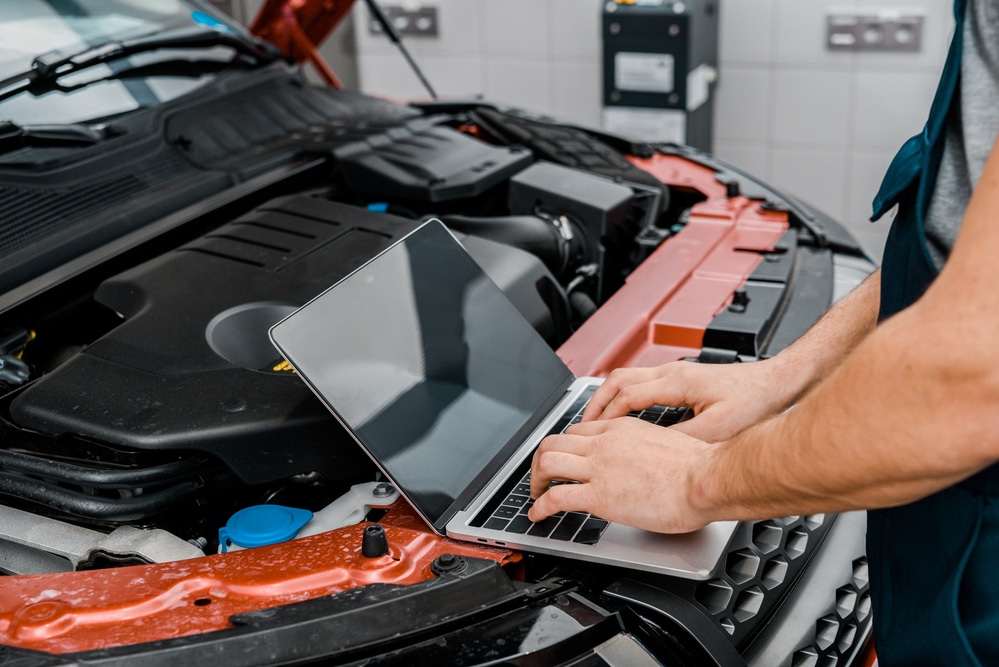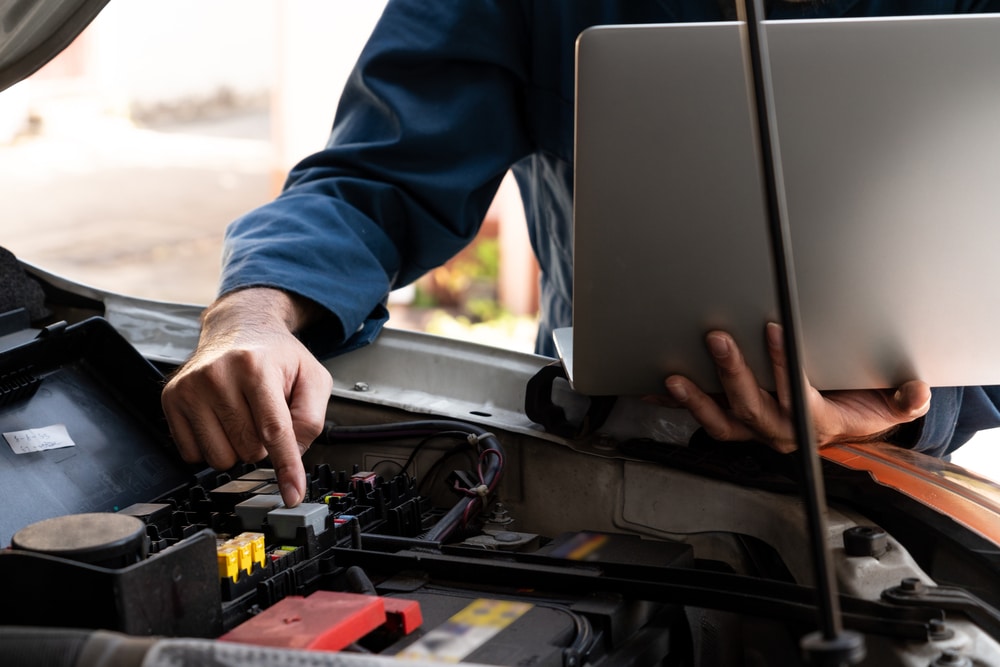Diagnostic devices are available in many different versions and multiple price ranges, from cheap and simple scanners to expensive, complex, and professional-level devices that can change a myriad of settings on the vehicle. Some devices are well suited for hobbyists due to their ease of use and simple, understandable language when reading out vehicle data, whilst there are complex diagnostic tools that should be left to experts. But wouldn’t it be nice to have an OBD2 scanner with Bluetooth?
So, are there OBD2 diagnostic devices with Bluetooth? At this moment, there is no device that can be completely controlled via Bluetooth. The reason for this is that vehicles have an OBD2 (On-Board Diagnostics) adapter which must be physically connected to the vehicle’s OBD2 (also known as OBD2) port. This interface is present in many vehicles manufactured after 1996, and all vehicles manufactured after 2004. Therefore, you cannot directly access and read out vehicle data via Bluetooth.
GAIN MORE CONTROL OF YOUR CAR WITH THE CARLY FEATURES
Check the exact pricing of Carly for your car brand!

Fast International Shipping with DHL

14 days adaptor return policy

Excellent customer support

Lifetime warranty in the hardware
SEEN IN
[lwptoc]
However, this does not mean that OBD2 diagnostic devices cannot use a Bluetooth connection to connect to a companion device for reading out error messages and other functions.
To What Extent Can a Bluetooth Connection Be Used to Read Out Vehicle Data With An OBD2 Scanner?
In order to answer this question, we shall firstly explain how an OBD2 scanner works.
There are generally two types of diagnostic equipment. On one hand, there are those that consist of a small device including the OBD2 Bluetooth adapter. This type of diagnostic device is usually connected to the scanner using a supplied cable, which in turn is connected to the vehicle’s OBD2 interface. As soon as the connection has been established, the device can start reading out the vehicle data. If the OBD2 scanner has a cable, there is usually no way to establish a Bluetooth connection with it.
The second type of diagnostic scanner includes an OBD2 Bluetooth adapter and accompanying software or smartphone app. In order to be able to use this kind of OBD2 scanner, the software or the app must be installed on your own computer or smartphone in advance. In addition, there are providers who offer a specific Bluetooth adapter that is compatible with the chosen software or app. Other providers do not sell a specific adapter, instead the buyer can choose between different models and price ranges. Whether a Bluetooth connection can be established between the adapter and the smartphone or software depends on the software’s capability, as well as the selected adapter having Bluetooth functionality
It is therefore important to consider whether you would prefer a Bluetooth connection or cable connection before selecting and purchasing a diagnostic device.
Should My OBD2 Scanner Have Bluetooth?
Ok, so far so good. But, how useful is an OBD2 scanner with Bluetooth, and what are the disadvantages of having a device without a Bluetooth connection?
Let’s be clear: the presence of a Bluetooth connection has no positive or negative impact on the other functions of the device. These functions can be utilized regardless of the connection, as they depend on the complexity and scope of the diagnostic device.
Nevertheless, it is an advantage to have an OBD2 Bluetooth scanner, as this can be used without the hassle of cables. For example, the OBD2 Bluetooth adapter can remain permanently connected to the car’s OBD2 port. If necessary, the Bluetooth setting can then be easily activated and connection with the software or app established. This is particularly useful for users who want to regularly check vehicle performance, and like to keep an eye on real-time monitoring of specific parameters, and those wishing to access the functions of the diagnostic device while on the move. For example, if a warning light comes on, the driver can quickly analyze the error memory at a rest area and determine whether the vehicle can continue to be driven, or whether he or she should seek a tow truck. Of course, this is also possible with a diagnosis device without Bluetooth functionality, but it may be more complicated to connect a wired scanner in order to be able to carry out the diagnosis afterwards, as well as the hassle of having cables in the driving area.
A disadvantage of the Bluetooth diagnostic device is that — depending on the quality of the OBD2 adapter — the Bluetooth connection with the smartphone or computer can be sporadically interrupted or even drop completely. This can be undesirable, so it’s best to make an adapter comparison in advance such as through online reviews, which will reduce the likleyhood of purchasing an adapter that could cause malfunctions or break after a short time.
What Other Functions Should My OBD2 Scanner Have?
The Bluetooth function is just one of many aspects of an OBD2 scanner. The most important properties that you should check and verify before buying a diagnostic device are the range of functions it offers, which functions you may regularly use, and whether you have the necessary knowledge to be able to use the device correctly. In addition, you should decide in advance whether you want to use the diagnostic device on only one vehicle, or whether you will require it for many vehicles from different brands. Finally, you need to decide whether you prefer a diagnostic device with software that runs on a computer, or if a smartphone-app-based solution is suitable for your needs.
What Are the Popular Functions Available?
The most important function of every diagnostic device, including OBD2 scanners with Bluetooth, is reading out the vehicle data, especially error messages from the vehicle’s fault memory. This is important because diagnostic tools are primarily designed to help mechanics identify faults and quickly find out which vehicle components need to be repaired or replaced. However, owners can also benefit from this function — for example to save themselves an inconvenient visit to the workshop by reading out the error messages from their vehicle by themselves and decide whether they can fix the problem directly or whether a visit to the workshop is necessary. Reading out a new error message, especially when on the road, can quickly dispel doubts and clarify whether the journey can be continued or whether the driver should call a towing service.
In addition, some diagnostic devices offer a useful function of supporting the regular maintenance of the vehicle. The vehicle owner can easily carry out a vehicle diagnosis with the aid of the diagnostic scanner and identify vehicle parts that may need maintenance or replacement. This function is particularly interesting for hobby mechanics who like to save themselves the trip to the workshop and prefer to do smaller jobs themselves. It is particularly helpful if the diagnostic device or the application has a user-friendly interface that guides the vehicle owner through the maintenance of the vehicle in just a few steps.

However, many diagnostic solutions have a much broader range of functions than error memory read-out and maintenance minders. Let’s take Carly for example. In addition to reading out data and maintenance minding, you can also carry out the exciting task of coding. Coding refers to modification of the functions of the car that are preset by the manufacturer. This can be carried out in a simplistic manner using an appropriate solution such as Carly with the Carly app and the Carly Universal OBD Scanner. One of the many coding options includes the front and rear lamps, the entertainment module, combination module and more. However, it is important that you do some research before embarking on your coding journey, as not all vehicle aspects can be coded.
Another useful feature of Carly is the Carly Used Car Check. Prospective vehicle buyers can use their device armed with the Carly app to connect to a vehicle using the Carly Universal OBD Scanner and read out the vehicle’s data. The odometer of a vehicle can be tampered with in quite a significant number of used cars by fraudsters. Carly allows you to identify this by checking the mileage across control units and comparing them, identifying any discrepancies.
As a rule, diagnostic devices with a broader function set come with a correspondingly higher price, so before making a purchase you should identify the functions that are particularly important for you, and how much you are willing to pay for it.
Also, not all diagnostic devices are suitable or available for every vehicle owner because they may require extensive technical knowledge, such as with professional-level devices. This is because many devices output analyses in the form of codes that can be easily understood by mechanics and technicians but may cause confusion for laypersons. The diagnostic device may end up discarded as a result, or the owner may mis-read the diagnosis and replace the wrong part.
Those who do not have expert knowledge but would like to try out a diagnostic device should therefore try out simpler solutions. There is a myriad of solutions out there, from devices that present errors in the simplest form, to those that offer comprehensive analysis. Some devices can only be operated after a lengthy trawl through their user manuals, whilst others have highly intuitive and easy-to-understand user interfaces. The latter type is particularly suitable for beginners as they can obtain a better overview of the various functions that are offered by the device and solution. However, if you have no idea of what is going on with your vehicle, you should do some preliminary reading before purchasing a diagnostic device so that you can understand the resulting error report correctly.
Would You Prefer a General or a Specific Diagnostic Device?
Not all diagnostic devices are universally compatible with all brands and models of car. Many diagnostic devices only support a certain brand or range of vehicle models. Therefore, you should consider in advance about whether you wish to use the device with only one vehicle of a single brand, or whether you will change your vehicle in the near future to a different brand. If you are unsure, a general diagnostic device would be your best bet.
This is particularly important as specific diagnostic devices cannot usually be modified or approved for other vehicles. Thus, an informed decision must be made at purchase. However, many vehicle owners may not mind this limited compatibility since they will often purchase the device for their own vehicle which they may wish to keep for several years. If a new vehicle is purchased down the line, the device might even be outdated by then. However, small workshops and hobby mechanics will wish for broader compatibility as they may have a look at the vehicles driven by their family and friends as well as clients in the case of small workshops, and therefore encounter various vehicle types and brands.
It can be advantageous to use a diagnostic device that is tailored to only one brand as this often allows a more precise analysis of the vehicle and its individual components. This type of diagnostic device can also be user-friendly as it is adapted to the user’s particular brand. Since this kind of device is also more cost-effective than general diagnostic devices, you should definitely consider which of the two options best meet your needs before making a purchase decision.
Software, Application or External Diagnostic Device?
There are diagnostic devices and solutions in various forms. On one hand, there is the classic external diagnostic device that can be operated via an inbuilt touchscreen, or in the case of cheaper and simpler models, buttons. These devices usually include an OBD2 adapter to directly establish a connection with a car and the software is directly installed on the device. Cheap variants of this device can be found from around €35 whilst there are devices that can cost a few hundred Euros and accordingly offer a greater range of functions.
Another variant is diagnostic software. This option is usually designed for advanced vehicle analysis and must be installed on a computer such as a laptop, or a tablet before it can be used. You also need an OBD2 adapter to connect to the vehicle via Bluetooth or cable. This variant is particularly exciting for experts and hobby mechanics as it offers extensive options for analyzing the vehicle, and presents highly detailed results about its current condition. In addition, this type of device also offers the coding function that we’ve mentioned in this article, where a vehicle owner can tailor individual settings to their liking. Due to these aspects, this type of diagnostic device is somewhat more complex than the previous type, and therefore suitable for those who already possess a moderate degree of technical knowledge. In addition, a laptop or tablet is required, which makes this avenue more suitable for use at home in a convenient manner.
The third avenue is the diagnostic app which can be downloaded to any smartphone. There are paid and free apps, the latter mostly offer free versions with a limited range of functions, whilst changing to the paid version unlocks a broader array. Depending on application, the manufacturer may also offer an OBD2 adapter to purchase that is compatible with the app, or the user may need to buy any generic OBD2 adapter and pair it with the app.
Most diagnostic apps are particularly impressive because they feature user-friendly interfaces and intuitive menus that guide the user through the various functions and steps. Another advantage of diagnostic apps is that they are updated at regular intervals and therefore do not become outdated. However, many manufacturers charge a monthly fee in return for using the app, in contrast to diagnostic software or external diagnostic devices which are one-time purchases. It is also practical to use diagnostic apps on the go, for example if you encounter a breakdown and wish to quickly evaluate the error messages before calling a tow truck. Coding is also possible with most diagnostic apps, and in contrast to diagnostic software, can be carried out relatively easily with the intuitive menus.

Therefore, it is apparent that diagnostic devices are available in various types and price classes, from simple devices that only read out error message to the fault memory all the way to professional-level complex devices with many exciting functions such as intensive analyses and coding features. Some are connected to a laptop via an OBD2 adapter and cable, whilst others use an adapter and Bluetooth. Some can also give you an insight into vehicle parameters in real-time whilst on the move.
So, users need to decide for themselves which is their perfect diagnostic device. This mainly depends on what you will use the device for on a regular basis, whether you just wish to evaluate error messages from time to time, need a maintenance helper, or wish to engage in coding. Maybe you’d also like real-time monitoring of your vehicle’s parameters whilst on the go. All these need to be considered.
Presenting Carly
Carly is a solution that consists of the Carly app which resides on your smartphone and offers a huge range of functions in addition to purely reading out and analyzing errors. These functions include coding, maintenance minding and the Carly Used Car Check. The Carly app connects to your car via the Carly Universal OBD Scanner which establishes a Bluetooth Low Energy (BLE) connection with your smartphone. Upon opening the Carly app, everything is presented in a clear and easy-to-navigate menu. Select the function and parameters and the app does the rest. The Carly app costs between €21 and €80 per year, and the Carly Universal OBD Scanner is a one-time purchase costing €59.90. Consider that a workshop may easily charge €50 per read-out of error codes, not including the travelling cost and time cost, and that it’s recommended to read out your vehicle’s error memory at least four times a year. You can see that Carly is not only a practical, but inexpensive alternative. On average, Carly users save €500 per year.

